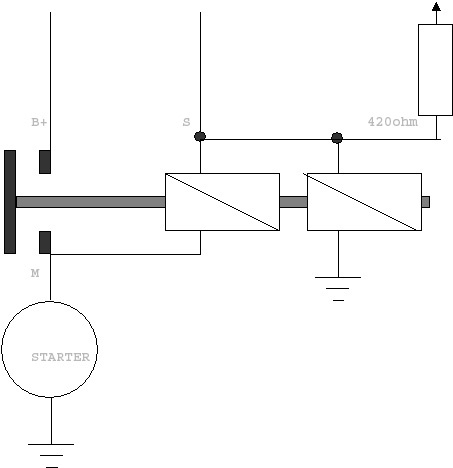Question starter circuit
starter circuit
QUESTION: The vehicle in question is a 1988 Nissan Pathfinder with a 3.0 l V6 engine.
On the starter motor solenoid there are 4 electrical connections. Large terminal to Battery, large terminal to the starter motor, small terminal coming from the ignition switch crank terminal (all normal) and another small one that has a 420 ohm resistor in the harness.
The starter "crank" solenoid wire and the one with the 420 ohm resistor are in the same two wire harness going to a 2 pin connector about 400mm from the starter.
My question is - what is this resistor for??? Mod, Alldata do not show it in their wiring diagrams. The harness is factory.
Regards
Peter
ANSWER: Peter,
This is the start ignition feed to the coils for extra boost to the system in start mode. When the ignition key is in the run mode there is no power feeding this wire back to the coils.
---------- FOLLOW-UP ----------
QUESTION: This vehicle is fuel injected with electronic ignition and does not use a ballast resistor in the ignition circuit. Even if it did, the ballast resitor would be around 1.5 ohms: not 420 ohms and wouldn't be in this circuit.
The circuit with the resistor is in a circuit that is only live on cranking and a 420ohm resisor would cause a massive voltage drop. If the circuit was to "boost the coils" as you state, there would be no resistor at all.
Regards
Peter
AnswerPeter,
It is a second path for current to feed the coils. Perhaps, I mispoke and this is the side that feeds the coils after the engine starts. Check the power feed, with the key on, and see if you are getting about 9 volts from the feed. If this is the case you found what the resistance in the circuit is for. Normally, the coil is fed with nine volts run and twelve volts at start. If you ran the coil at twelve volts all the time it would either cook the coil or burn the electrodes off the spark plugs.
